Finders Keepers: Artist Amy Pilkington’s Live-Work Loft in Beacon
By Mary Angeles Armstrong | Photos by Winona Barton-Ballentine | Spring 2024 | Apartment Feature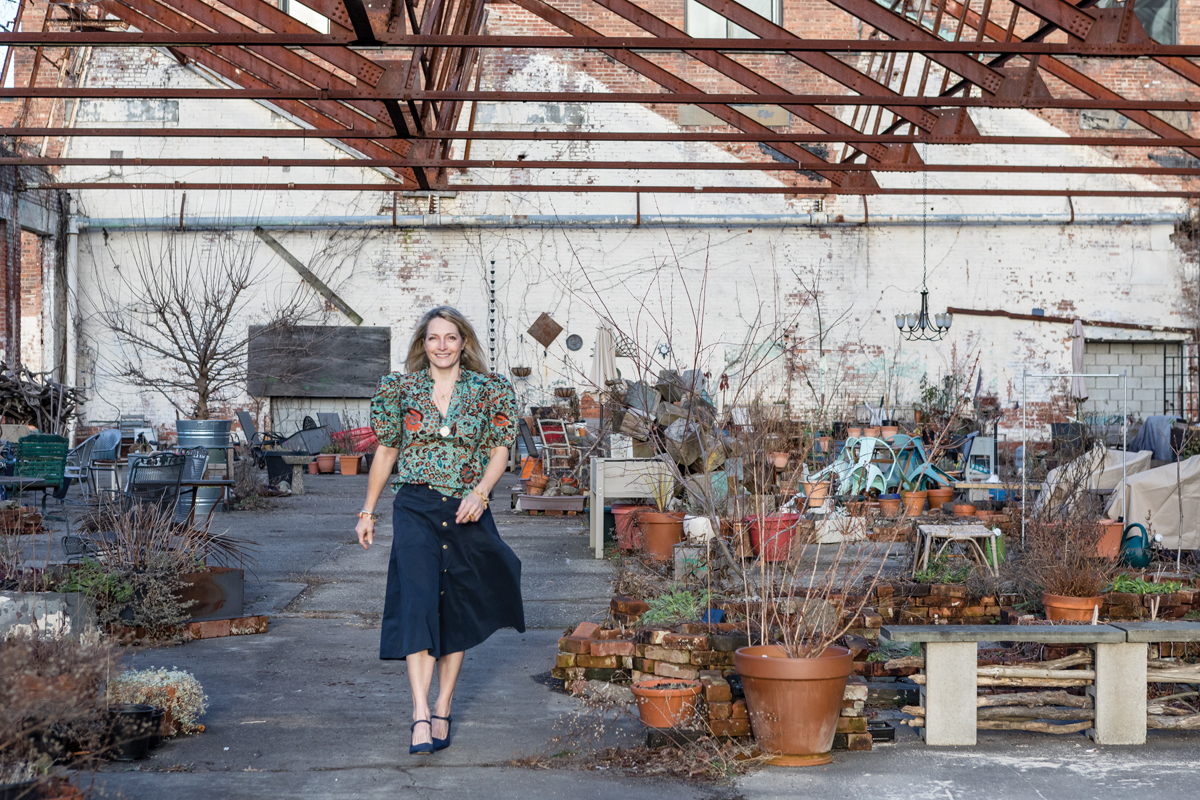
“My sister calls me the magpie,” says Amy Pilkington, of her lifelong tendency to find eye-catching objects and squirrel them away. “I’m just always collecting, and finding things everywhere.” On display throughout the bright interior of her two-story, open-concept loft (itself a great find), her salmagundi of treasures gleams in the sunlight spilling from floor to ceiling windows. Pilkington plucked most of her finds while walking along the waterways of the world, but also diving through dumpsters and mining her family’s history for bits of faded glamor (and the tales to go with it).
In Plinkington’s orbit, the flotsam she’s gathered comes to life. Striped rocks, placed just so, tenderly nuzzle each other. A mass of entangled roots becomes a quarter horse grazing out to pasture. The graceful torso of a woman is frozen in a trunk of driftwood, as if the gods suddenly transformed her into a tree to preserve her virtue. “I think actually she looks like she has to pee,” says Pilkington of the found sculpture propped up in the corner of her studio. (Across the walkway from her loft, another great find. )
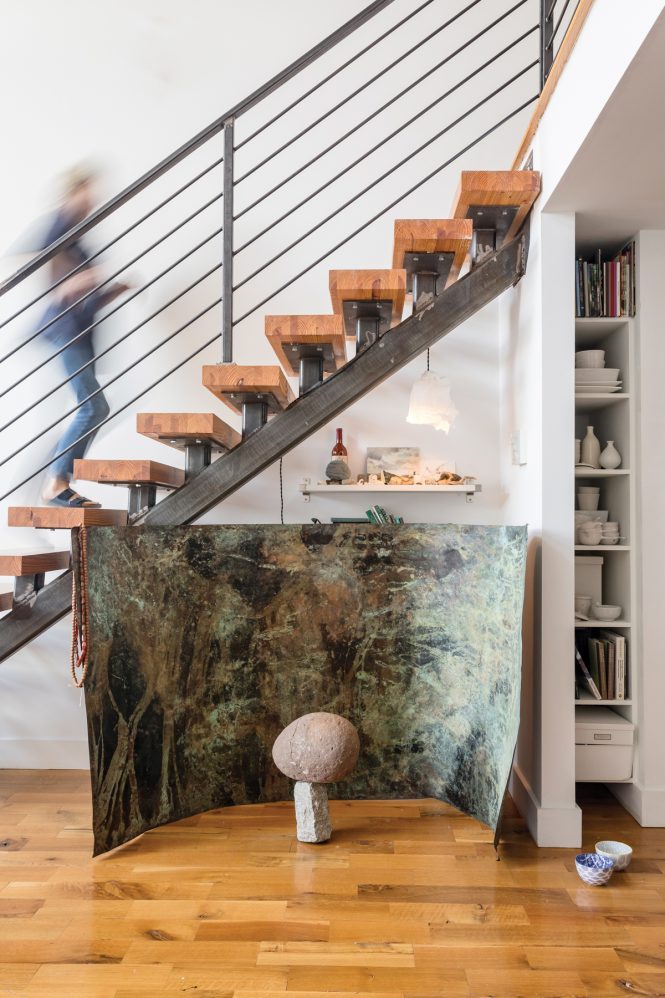
Amy Pilkington’s Beacon loft is filled with both her art and scavenged finds. Here, she’s paired one of her paintings with cantilevered, balanced rocks. She colored the copper sheet by treating it with alternating layers of chemicals and wax. “I love the sculptural quality it’s taken,” she explains. “It used to hang on the wall, now it stands on its own protecting its massive but precarious stone cohort.” She calls the rock sculpture The Tippies. “It’s sort of a love story,” she explains of the evolving display.
Both her apartment and studio look out over a 12-acre mixed-use complex along the Fishkill Creek. Once a textile mill, the brick, industrial complex is the center of a thriving community with 200 loft apartments and studios, a shared garden, and meeting spaces. With about half of the residents working in the creative arts, Pilkington fits right in. “It’s a blend of industrial and functional with a dash of elegance and humor,” she says of her evolving constellation of spaces. “I enjoy playing with the surfaces and reflections that make objects come to life at different times. I enjoy the sparkle factor. “
From the Fishkill Creek to the River Murray
A native of Australia, Pilkington’s keen eye for the natural world grew from her early connection to horses. “I started riding when I was very young,” explains Pilkington. “I’d spend weekends riding through the outback with my pony. I loved being out in the wilderness and started picking up rocks and trekking them back home.” When she was 11 Pilkington’s father took a job in New York City and the family moved from their home in Melbourne to Connecticut. Through her school years at the Greenwich Academy and then Northwestern University, she developed her eye for design motifs, collecting antique Tibetan textiles.
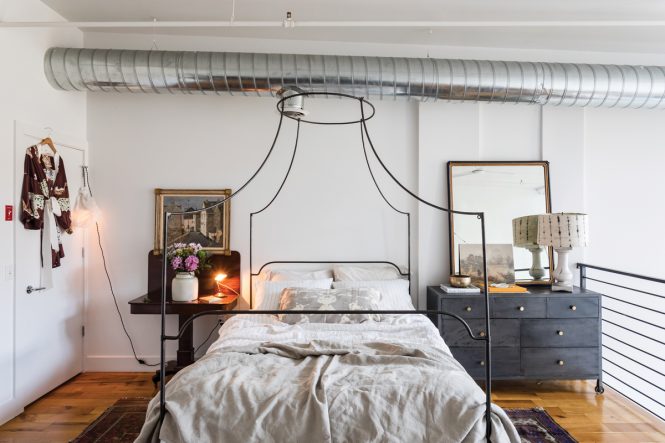
In Pilkington’s mezzanine bedroom, a metal-framed bed is covered with natural flax and naturally stripped linens handcrafted by her downstairs neighbor Jason Evege at his Peekskill-based linen company Linoto. The paintings on either side of the bed are by her grandfather, the Australian artist Ron Skate.
At the Savannah College of Art and Design, Pilkington honed her specialty of metalsmithing and jewelry making and then landed a plum gig with Ralph Lauren. “I was commissioned to create a bronze horse that looked like it was found in a Parisian flea market,” she explains. It was a perfect synthesis of her interests—horses, flea market cast-offs, and metal craft—and the project was a success. “It’s still in their stores throughout the world.“
From there Pilkington’s career was off—she was able to become a full-time jewelry artist and develop her other creative pursuits. “I’m a multidisciplinary artist, sculptor, metalsmith, and jeweler but I also fell in love with textiles and found objects along the way,” she explains. “I‘ve always been fascinated by how to put things together and take them apart creating new things.“ Her creative career took her from Savannah to Manhattan and then out to East Hampton where she helped design and run the Elaine De Kooning House artist residency for 15 years.
Shaggy Dog Scavenger Hunt
During Pilkington’s time in the Hamptons she rediscovered her early love of wild foraging when she adopted her Italian greyhound, Pippa. “She was so hyper that I’d have to walk her for hours on the beach to calm her down,” she says. “It thought that I might as well do something while I was walking, so I brought a bag and began to collect things.”
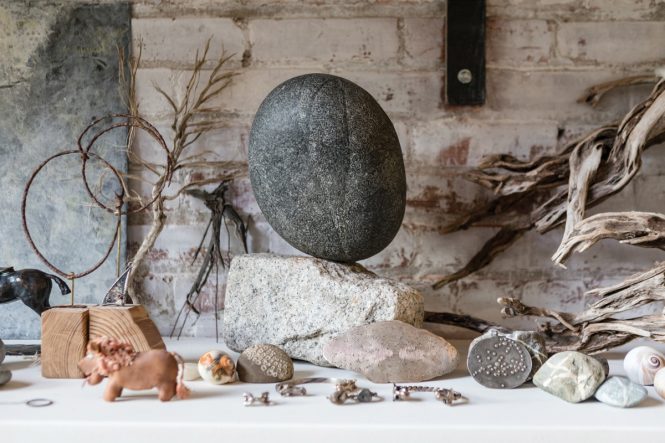
A collection of Pilkington’s found objects on display in her studio. She found many of the objects on nature walks where she hunts for inspiration. “Some days I gather all white rocks to see the color variations, other days I’m hunting for heart rocks,” she says. “And I’m always on the lookout for good striped rocks.” She also collects driftwood, shells, and fibers and adds them to her mementos. “My collection are little encyclopedias—a snapshot of the moment and time it was created and how it survived crossing my path,” she says. “It’s a constant riddle or puzzle: What conditions gave rise to this? Is it a tool? Is it a rock? Is it a fossil?”
She began collecting foliated granite rocks with fossilized stripes through the center. She also developed an eye for driftwood, as well as an appreciation for the detritus brought in by the tide, both natural and man-made. “I’m very curious and get inspired while exploring and collecting things,” she says. “It’s fascinating to me how natural colors and patterns combine with such beauty, genius and humor.”
Pilkington’s collections began to amass—and then to synthesize. Her finds started making their way into both her work and her decor. “I’d been making jewelry for so long and collecting gemstones,” she says. “And then it occurred to me, ‘what if I just put them all together? Like, wouldn’t that be so crazy?’”
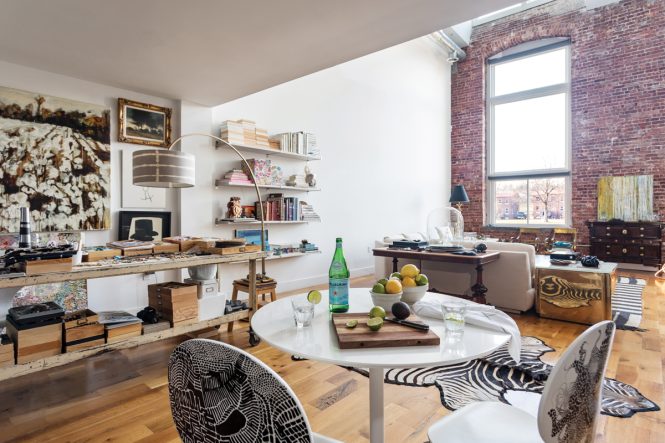
The High and the Low of it
Pilkington found her way upstate in 2018 to be closer to her sister and nephew. “I was looking to live within an hour of Greenwich so my nephew could visit,” she says. “A friend had just moved to one of the lofts here and suggested I look. I was extremely fortunate to find a wonderful bright loft and a large street-level workshop.” Built in 1876 as the Groveville Carpet Mill, the row factory building, workers’ housing, and gate house successively morphed to manufacture fabric, furniture, and embroidery through the 20th century. Over the Fishkill Creek the hydroelectric spillway dam once powered the factory and is still functioning. In 2012 the property was reinvented as a live-work housing complex with modern lofts, workshop studios and office space.
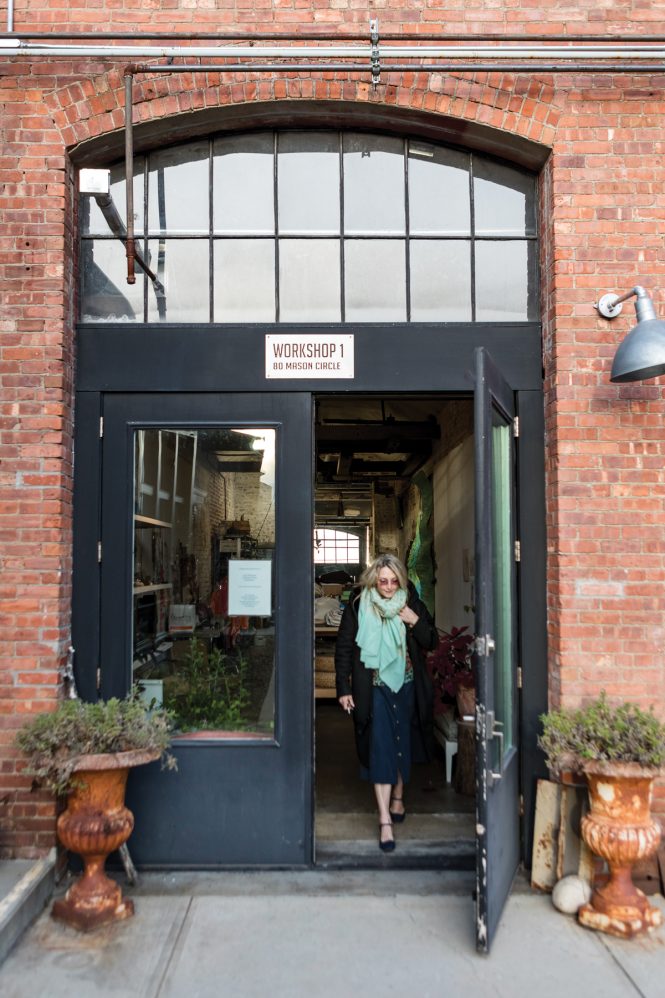
Pilkington’s studio sits in an adjacent building that was once part of the hydroelectric power plant for the larger mill. She continues the space’s history with her own type of creative industry. “My art is an interactive experience,” she says. “It grows and
In Pilkington’s apartment exposed brick, sky-high two story ceilings, and exposed metal piping lend an air of industry, but her distinct sense of creative whimsy spills out along the edges. “My aesthetic is derived for my passion for found treasures mixed with my collection of vintage steel pieces and furniture I’ve inherited from family,” she explains.
Pilkington grounded the first floor sitting area with an oversized, 1960s down sectional and brass end tables from her stepfather, then searched high and low for a coffee table that had the gravitas to match. “I couldn’t find anything that was the right style or dimensions,” she says. “I wanted it to look like it was floating, so it wasn’t too heavy,” says Pilkington. “But it needed to be the right style and dimensions.” She commissioned her neighbor to create a large coffee table frame out of scrap wood and then finished the wood surface with sanded layers of burnished wax and graphite. The piece’s art-from-trash elegance is classic Pilkington. “The screws and imperfections are all visible but are elevated by the silky lacquer-like finish,” she says. “It’s the ultimate high-low piece. “
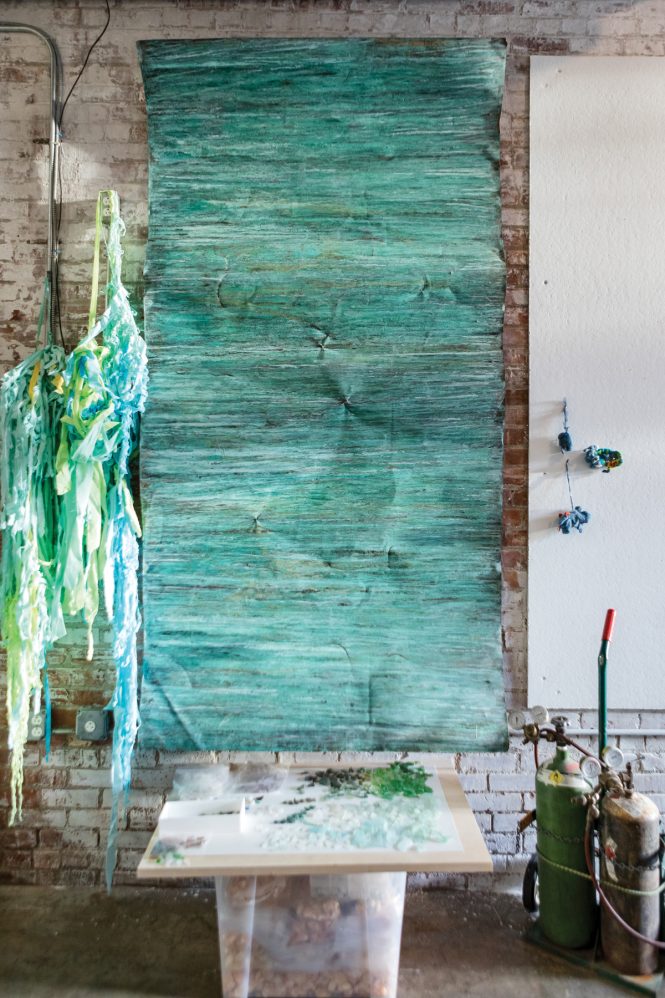
Hanging in Pilkington’s studio, another sheet of copper is a 14-year work-in-progress. “The color is derived from a mix of vapor and chemical patinas,” she says. The green is matched with her collection of river glass gleaned from walks along the Hudson.
An oversized workbench, a gift from her sister, dwarfs the first floor dining area and is piled high with Pilkington’s work-in-progress jewlery. Recently, a trip back to Savannah resulted in a collection of various shark teeth which she’s transforming into rugged, elegant pendants. Collections of beads, shells and metal work are all in the painstaking process of being assembled to tell a color story. On the facing wall,landscape paintings by her grandfather, the painter Ronald Skate, depict the Australian countryside from a century ago.
All at Once
Throughout the second floor mezzanine, Pilkington’s textile collections give the space a softer feel. A commission from a hotel out west led her to experiment with fabric dye motifs. Pilkington paired some of those results with textiles from a neighbors linenware line and fabric saved from her youth, then matched it with an iron canopy bed from her sister. Coffee table books—another growing collection—line the metal balcony rails and paintings from her grandfather’s travels hang on the walls.
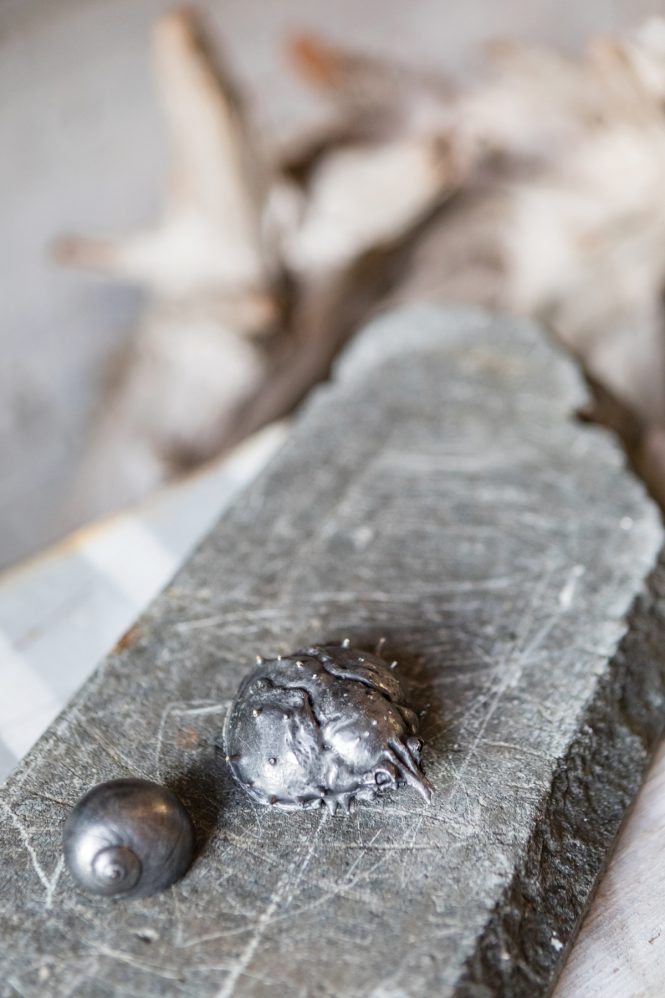
One of Pilkington’s rocks engraved with circles sits with a silver shell and a pendant that reminds Pilkington of a map to a galaxy. “There’s no deliberate intention to the patterns,” she says. “But I feel as though it’s a language I have yet to understand or recall. “
Outside, across the complex driveway, Pilkington’s studio reaches from the sunny street deep into the factory bowels. Curved glass double doors open onto a foyer brimming with plants. Another stretch of workbench extends under the high domed roof. Shelves run along the brick walls back to a wet room covered with art, artifacts, and natural treasure.
As Pilkington handles each piece, she tells its story. Each rock has a name, a feeling and an expression of delight or disgust. A piece of driftwood is a man weeping into a tree. As soon as Pilkington tells it, each piece immediately springs to life with the story she’s given it, and you believe her. The stories becomes hard to un-see. “I’ve always made things,” she explains. “Everything and nothing all at once. ”
